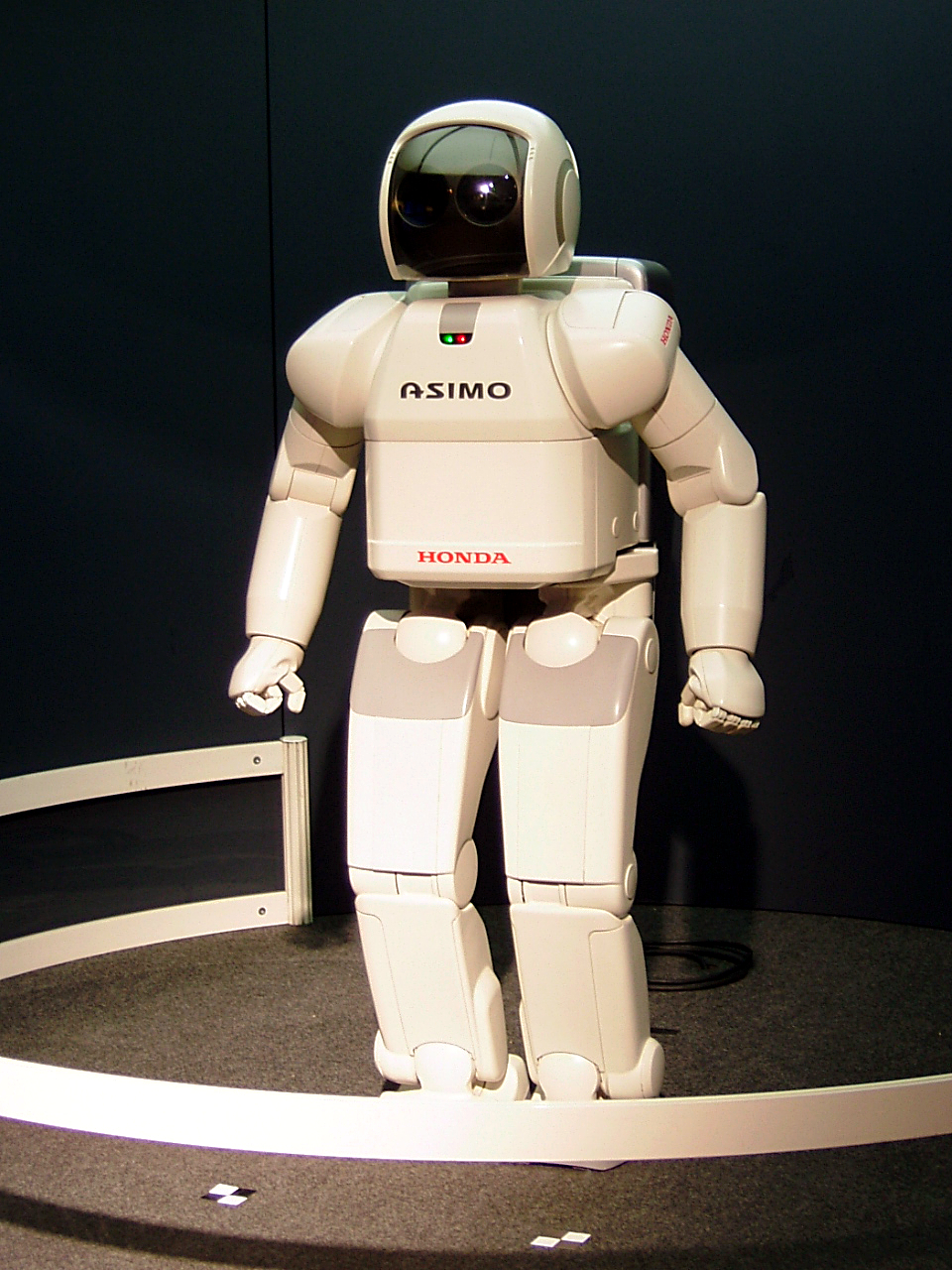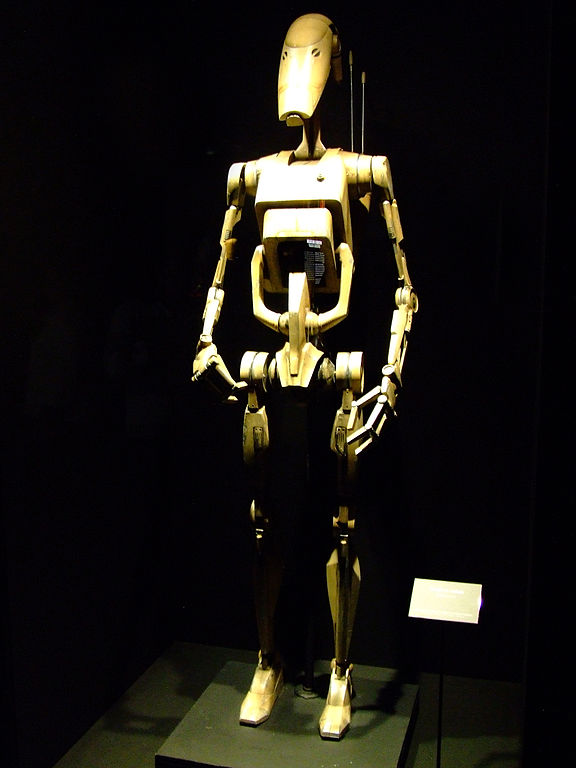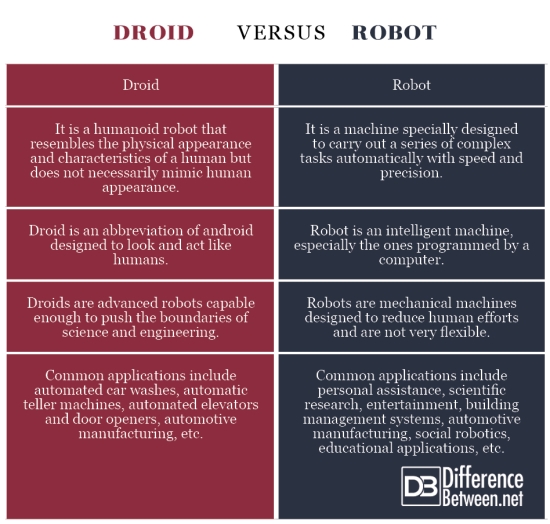Difference Between Droid and Robot
Technology has evolved beyond those smart driverless cars or unmanned aerial drones or automated assistants for that matter. In fact, technology behind robotics has come a long way since the first digital and programmable robot called the “Unimate” was built by George Devol in 1954. Over time, robotic technology has been integrated into every facet of our lives from industrial and medical robotics to construction and entertainment robotics. The idea was to get robots closer to human social needs so that no one would be able to tell a difference whether it’s a human or a human-like robot. We have definitely made progress as technology helps humanoids overcome the uncanny valley. Artificial Intelligence combined with robotic embodiment has ushered in a new era of advanced robotics. First there were robots, and then came humanoid robots (or android) which begs the million dollar question – are robots and droids the same thing?
What are Robots?
The terms robot has been around for quite some time, with deep roots in fictional science. Although everyone seems to know what a robot is and what it does, but there’s no specific definition of robot. Robots are presented in many different ways in the media, especially the doomsday scenarios are occurring more and more often. However, in technical terms, robots are machines, mechanical machines, mostly software-driven, designed to accomplish a series of actions or tasks that are too dangerous for humans to handle. Robots are so designed to reduce human efforts as much as possible or to perform tasks that are too dangerous for humans to handle.
What are Droids?
Droids are short for androids, which are humanoid robots that share physical resemblance to humans but their internal mechanisms link them to modern robots. Droids are the forerunners of robots that allow interaction with made-for-human tools or environments. They are humanoid robots with their overall appearance based on the human body and unlike robots, they refer to sensing, actuating, planning and control. They can adapt to changes to accomplish their goals which makes them more complex than their robotic counterparts. Droids are like autonomous robots designed to aesthetically resemble a human but not necessarily a human.
Difference between Droid and Robot
-
Basic
While on the surface, both robots and droids might seem like automated machines designed to carry out a series of tasks, but they share their fair share of differences. A robot is a computer-programmed machine specially designed to carry out a series of complex tasks with speed and precision. It’s something that imitates a human but does not necessarily look like a human like androids, which, on the other hand, are human-like robots designed to look and perform tasks similar to humans. Androids are basically humanoid robots designed to look like humans. Droid is an abbreviation of the term android, which refers to a robot which may or may not look like a human.
-
Technical
In technical terms, robots are intelligent machines, mostly mechanical and electrical, designed to look and act like a human. It is more of a system containing sensors, control systems, power supplies, hardware, and software all working together to perform a complex series of actions automatically without human involvement. Droids (short for androids), on the other hand, are robots with some physical resemblance to humans but does not necessarily mimic human appearance, but are often mistaken for real people. Both the terms robot and droid are synonymous except all droids are robots but not all robots are droids.
-
Purpose
Robots are efficient and intelligent machines designed to reduce human efforts by automated means and in the less time possible. The purpose of robots is to perform repetitive actions or tasks that are too dangerous for humans to handle. They are state-of-the-art machines that are capable of performing dangerous tasks without endangering human lives. Droids, on the other hand, are human-like robots specially designed for functional purposes like moving heavy loads, do industrial operations, do household works, and more in much efficient ways but more humanely. Droids are advanced robotics capable enough to push the boundaries of science and engineering.
-
Use
Robots use automation to carry out simple to more complex mechanical tasks that require a little human touch. Robots play a significant role in today’s industrial and manufacturing ecosystem including automobile manufacturing, consumer electronics, medical operations, military operations, entertainment industry, and even space. Common use of robots include automated car washes, automatic teller machines, automated elevators and door openers, smart homes, smart appliances, drones, and more. Droids are employed in a range of applications such as personal assistance, scientific research, entertainment, building management systems, automotive manufacturing, social robotics, educational applications, and more.
Droid vs. Robot: Comparison Chart
Summary of Droid vs. Robot
The advances in technology and computational intelligence have ushered in a new era of advanced robotics. Advances in wireless communication and artificial intelligence are being combined with mechanical ingenuity and intelligent machines. When we’re talking about robots, we don’t mean humanoids, but smart machines, especially the ones programmed by computers, capable of performing complex tasks with utmost speed and precision with the sole purpose of reducing human efforts as much as possible. Droids, on the other hand, are humanoid robots that look and act like humans but does not necessarily mimic human appearance. In a nutshell, all droids are robots but not all robots are droids.
- Difference Between Caucus and Primary - June 18, 2024
- Difference Between PPO and POS - May 30, 2024
- Difference Between RFID and NFC - May 28, 2024
Search DifferenceBetween.net :
Leave a Response
References :
[0]Thompson, Steven John. Androids, Cyborgs, and Robots in Contemporary Culture and Society. Hershey, Pennsylvania: IGI Global, 2017. Print
[1]Nocks, Lisa. The Robot: The Life Story of a Technology. Westport, Connecticut: Greenwood Publishing Group, 2006. Print
[2]Nakamura, Yoshihiko. Advanced Robotics: Redundancy and Optimization. Boston: Addison-Wesley, 1991. Print
[3]Image credit: https://en.wikipedia.org/wiki/Portal:Robotics/Featured_robot#/media/File:HONDA_ASIMO.jpg
[4]Image credit: https://upload.wikimedia.org/wikipedia/commons/thumb/e/e2/Battle_Droid_B1.jpg/576px-Battle_Droid_B1.jpg



